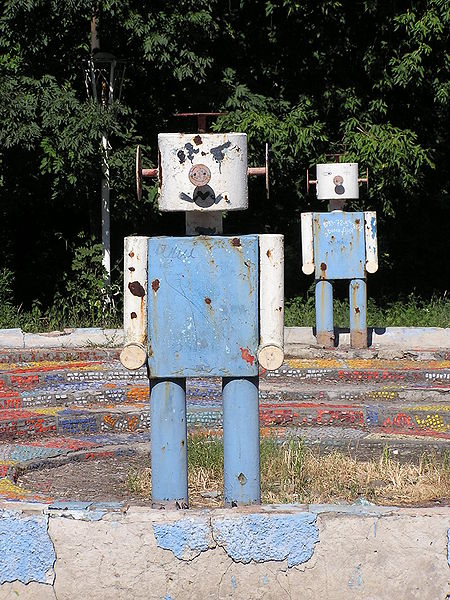I’ve probably posted something about swarmbots being programmed to create their own language, but Marcus du Sautoy sums up the experimentation really well in a new article about the Turing Test in the Guardian. An excerpt:
“For me one of the most striking experiments in AI is the brainchild of the director of the Sony lab in Paris, Luc Steels. He has created machines that can evolve their own language. A population of 20 robots are first placed one by one in front of a mirror and they begin to explore the shapes they can make using their bodies in the mirror. Each time they make a shape they create a new word to denote the shape. For example the robot might choose to name the action of putting the left arm in a horizontal position. Each robot creates its own unique language for its own actions.
The really exciting part is when these robots begin to interact with each other. One robot chooses a word from its lexicon and asks another robot to perform the action corresponding to that word. Of course the likelihood is that the second robot hasn’t a clue. So it chooses one of its positions as a guess. If they’ve guessed correctly the first robot confirms this and if not shows the second robot the intended position.
The second robot might have given the action its own name, so it won’t yet abandon its choice, but it will update its dictionary to include the first robot’s word. As the interactions progress the robots weight their words according to how successful their communication has been, downgrading those words where the interaction failed. The extraordinary thing is that after a week of the robot group interacting with each other a common language tends to emerge. By continually updating and learning, the robots have evolved their own language. It is a language that turns out to be sophisticated enough to include words that represent the concept of ‘left’ and ‘right.’ These words evolve on top of the direct correspondence between word and body position. The fact that there is any convergence at all is exciting but the really striking fact for me is that these robots have a new language that they understand yet the researchers at the end of the week do not comprehend until they too have interacted and decoded the meaning of these new words.”
••••••••••
Luc Steels talks robot culture at TED:

